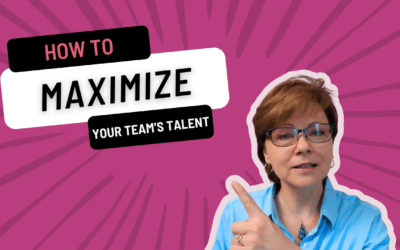How companies can attract right fit candidates.
The text below is adapted from a live stream conversation.
In this installment, we’re focusing on Recruitment Marketing. This is an area where lots of companies need to be better right now, because so many businesses are struggling for great candidates.
For that reason, I’ll share with you some of the insights and observations that I’ve had as a communication strategist, along with a specific example of how this technique can be applied.
The Concept of the Right Fight Candidate
I first want to discuss why we need “right fit” candidates and not just “right now” candidates.
When you are struggling for employees, it can be really tempting to just go for the “right now” candidate. You just need bodies.
And for that reason, a lot of businesses are putting out recruitment messages that lead with the compensation plan.
I can’t tell you how many radio ads I’ve heard that start out with what they pay, or how you can earn paid time off, or what the signing bonus is.
What companies find long term, however, is that the great starting salaries and the signing bonuses only get you so far, they get you the “right now” candidates.
But often, as soon as that employee has met the threshold for when they qualify for that signing bonus, maybe that’s just 30 days or 60 or 90 days out, there’s sometimes jumping ship to the next great offer.
So you’ve solved an immediate problem, but you haven’t solved the long term issue of “right fit” candidates, not “right now” candidates.
Now, don’t misunderstand me. Quality wages and signing bonuses can be a component of a great Recruitment Marketing campaign. But if you stop there, you’re really missing out.
If you’re in HR, you already know this: the cost for turnover is tremendous. National averages for employee turnover range from half the annual salary to two times the annual salary to replace that employee.
So this is really something that businesses need to get a hold of as you’re hiring for a specific season or long term.
The way that you approach recruitment from a marketing perspective will have a lot of impact on the quality of candidates that you ultimately find, and how they will blend with your organization.
How to Start the Recruitment Marketing Conversation: It’s All About Connection
The first thing I want you to think about is instead of leading with compensation, lead with connection.
You want to connect your prospective employee to the mission or the vision of the organization, the long term future aspirational state that they have in trying to find the organization that they want to work with.
If you think about a time in your career when you explored a job opportunity, you probably knew that you were looking at spending, in some cases, more time with your colleagues at work than with your family at home.
Some people are also considering moving. Where you work could determine where you live, where your family gets to vacation, where your kids go to school.
There’s a lot wrapped up into a decision to work for a company.
So this is a two-way street.
When you lead with connection, connecting the employee to their desired future state, you’re getting beyond just that 30 or 60, or 90-day signing bonus that they may be initially attracted by.
You’re actually helping them connect with the long term picture of how this organization will help them succeed.
You want them to succeed financially, but you also want them to succeed emotionally. You want them to succeed intellectually.
Talk to them about professional development, about the vision for the organization, about culture fit. This is how organizations that are winning at recruitment marketing find the best fit.
A Real Life Scenario of Recruitment Marketing Done Well
Let me give you an example of what this concept looks like. Because you may already be thinking: “Oh, well, that will only work if you’ve got a really high-level managerial technical job or something like that.”
No, no, no. This works at every level.
In the fall of 2019, I started working with a steel manufacturing company in Virginia. They actually had four manufacturing plants across the east coast at that time. And like many organizations, they were struggling with recruitment.
This was pre-pandemic and they were already feeling the workforce pinch.
They were slowing down their production because they didn’t have enough welders and fitters to actually manufacture and fit the steel that they needed to produce for the jobs.
They were feeling like they potentially could not bid on certain jobs because they weren’t certain they could fulfill it because their workforce had such a shortage.
They were in an area where many organizations may be in, struggling with a lot of competition for welders and fitters.
If you looked at their ads, you saw, like every other steel company in the area was doing, communications highlighting the compensation above everything.
Every communication was about “a starting salary of $18 an hour”, “$18.25 an hour”, “$18.50 an hour”, “two weeks vacation”, “three weeks of vacation”.
The problem: All the ads talked about compensation first.
You know how many talked about connection first or culture fit first? None.
So there was a huge opportunity there.
The first thing we did was to talk to the leadership team of the steel company to discuss the qualities of a right fit candidate for the organization and for these positions.
We always recommend first looking at the situation from the organizational level. Whether you’re a janitor or you’re an executive, there are certain culture fits that your organization may want to put forward.
What are they? What would make somebody successful here? In this case, we created a profile of that “right fit”, not just “right now” candidate.
We then completed more interviews to get perspectives from four different angles:
- Leadership
- Top employees in the company
- Employees that had left the company
- Brand new employees in the company
All of it was designed to figure out what makes an employee really successful at this organization long term, beyond the 30, 60, or 90-Day signing bonus.
One of the comments that stood out to us from the interviews was about the pride that the welder and fitter, who is a great long term fit for the organization, had in their work.
The guy said essentially: “Sometimes I take a different route home, just to look at the buildings that we’ve made.”
And that comment hit me hard. And I said THAT’S IT. That’s exactly what we need to focus on.
This steel manufacturer was doing some pretty high profile work: They were doing terminals at airports, wings at children’s hospitals, high rises in downtown Manhattan, sports arenas and stadiums that you probably would know if I said the name of. Very, very high profile things.
But their recruitment marketing wasn’t talking about that at all. It wasn’t talking about connecting the person with the work that they do.
The other thing that we heard in the interviews was that many of the best candidates brought their own sense of pride with them, their own sense of recognition and empowerment.
But the ones that were borderline maybe needed to be reinforced a little bit because they wanted to be seen as real craftsmen, not just the guy with the welding torch or something like that.
They were real craftsmen. Again, these complex high-profile structures that the company was building needed that sort of craftsmanship.
So that was another profile component of making a right fit candidate for this steel company. So what we did as part of their recruitment marketing campaign was to completely rewrite what they were putting out in their marketing pieces.
Yes, compensation was part of it, but it wasn’t the lead. It became a harmony line, but not the melody.
The lead statement we produced for them for their recruitment marketing campaign sounded like this:
“Build the structures that define cities and Skylines for generations.”
Now, if you hear that, and your heart doesn’t beat a little faster as a welder or a fitter, this is not the right fit for you. And that’s okay.
So that was the lead line, everything else flowed out from there.
Help Your Candidates Picture a Future With You
There was more discussion in their recruitment marketing material about what this candidate could produce, not just in the work that they did, but in the support the organization would give them in their professional development.
We invented an “Acme Steel Academy” that helped the candidate see the path forward from where they may be starting as entry level, all the way up through master craftsmen.
They would see themselves really becoming part of an artisan-level welder fitter.
And all of that came together for the recruitment.
They took that immediately to a Job Expo that they had been participating in year over year. And right away, they had three times the number of applications from that job fair that they typically did.
They also found out that the quality of applicants was much better. So the quantity and their quality went up.
This means that the quality applicant became… say it with me now, the “right fit” candidate, not just the “right now” candidate.
In summary, this example teaches us to lead with the connection of your prospective employee to their desired future state before you lead with compensation.
I promise you that one change alone will make you better at recruitment marketing.
Make The Process Simple And Clear
Another mistake I sometimes see in Recruitment Marketing is making the application process a little too confusing, a little too difficult for our prospective employees to know how to be successful with our organization.
When starting the application process, “Apply Now” is a very specific call to action.
Think about everything that the action involves. For example:
- Do they need to upload a resume?
- Do they need to upload and provide a letter of recommendation?
- Do they need to write an intro letter?
- Are they just filling in the blanks of an online form?
Whatever it is that your organization does, spell it out, build a yellow brick road for these right fit candidates to find you, and then apply with you, and then know what it is that they’ll need to do to succeed with your company.
So again, one of the things that we found useful in our previous work with the steel company was helping the candidate see the picture of success they could have post-hiring:
- What will you help them do to succeed professionally?
- What does their future state look like?
I think as employers, sometimes we get all wrapped up in what we need right now and we forget about what the employee needs.
They’re making a decision too.
And if you want them to stay with the organization long term you have to show them a little bit about what that long term success and connection are going to look like.
Also Think About Employee Retention
Finally, you want to make sure that you are continually, routinely connecting the employee with not just their personal future state that they want, but also with the longer term mission and vision of the organization.
Your right fit candidates are with you for more than just the paycheck. They’re with you because something that you do speaks to them.
They see themselves in this future vision. And if you’re not reinforcing what that future vision is, they’re going to make up one on their own. And it may not be one that you agree with.
So routinely reinforce what that future vision and mission is for the organization so that the employees have a chance to connect with it over and over and over again.
That way they’ll know that they’re driving towards something. They’ll know they’re part of something. They’ll know that everything they do leads towards something.
This “something” doesn’t have to be really grand and highbrow. It could be as simple as:
- “Everything that this company does is about creating fun.”
- “Everything that this company does is about creating inclusion.”
- “Everything that this company does is customer first.”
- “Everything this company does is about celebrating animals in their wild states.”
Whatever it is that is consistent with your organization’s mission and vision, please make sure that you’re communicating it routinely. And if you’re not, that’s a problem you can fix.
Start working with your leadership team, your managers, and make sure that you’re reinforcing that so the people know why they’re with you.
Attract Talent with Staying Power

Employee turnover in the manufacturing industry costs $55k – 65k per open position. Ouch!
Discover today’s top secrets to turn your recruiting efforts into a magnet for culture-fit employees that will stick around.



